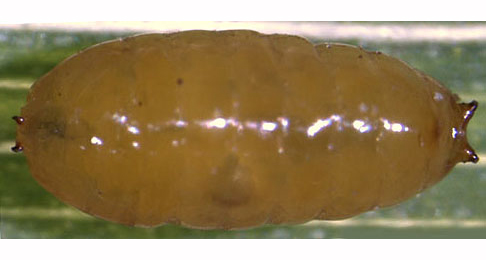|
||||||
|
SECURIGERA. Goat pea and Crown Vetch. [Fabaceae] |
|
Two species of Securigera are recorded in Britain. Five British miners are recorded on Securigera. A key to the European miners recorded on Coronilla including Securigera is provided in Bladmineerders van Europa. |
|
Key for the identification of the known mines of British |
1a > Leaf-miner: Larva producing a short narrow linear mine not associated with the margin, which then develops into a conspicuous white blotch centred on the mid-rib. At the end of feeding the larva lies for one or two days along the mid-rib. Pupation external (Spencer, 1972b: 37 (fig. 114b); Spencer, 1976: 126, fig. 213A). Broad and short hook-like upper-surface corridor, ending in a little blotch in the centre of a leaflet. The blotch is upper-surface as well, but has some deep spots, giving the mine a mottled appearance when hold against the light. Frass in the blotch in a few large lumps. Pupation outside the mine. A short, broad gallery leading to a conspicuous, roundish white blotch in the centre of the leaf. The blotch is upper surface with full depth spots - comprising of large clumps of frass. Puparium reddish |
|
Agromyza nana Meigen, 1830 [Diptera: Agromyzidae]. |
1b > Leaf-miner: An upper or lower surface shallow winding linear mine, which may develop into a secondary blotch. Pupation external (Spencer, 1976: 240). Puparium orange Upper- or lower-surface, greenish or whitish corridor, sometimes a blotch. The corridor does not widen much and is not associated with the midrib. Frass in conspicuous thread fragments, alternating along the sides of the corridor. Pupation outside the mine. The mine is also illustrated in British Leafminers. |
|
Liriomyza cicerina (Rondani, 1975) [Diptera: Agromyzidae]. |
1c > Leaf-miner: Corridor leaf-mine in leaves. An upper surface linear mine with frass in conspicuous greenish strips, largely alternating at each side of the channel (Spencer, 1976: 241). Upper-surface, unbranched corridor, relatively broad from the start on, but only weakly widening subsequently. The fresh mine is bright green, but turns whitish, later brown, quickly. Frass in a wide green band in the centre of the corridor, with small black granules at either side. Pupation outside the mine. Forms an upper surface mine, with the frass in a green strips. |
 Liriomyza congesta puparium Image: © Willem Ellis (Bladmineerders van Europa) |
|
Liriomyza congesta (Becker, 1903) [Diptera: Agromyzidae]. |
1d > Leaf-miner: The frass is arranged in a spiral and a circular blotch is formed. Egg at the underside of the leaf. The mine is an upper-surface blotch without anything like a preceding corridor. The blotch is about circular, but my have broad lobes. Black frass grains lie in indistinct arcs or spirals, glued to the upper epidermis, and forming a cark central patch. The larva can leave a mined leaf, and restart elsewhere. Pupation external. Cocoon spun beneath the leaf. |
|
Leucoptera lotella (Stainton, 1859) [Lepidoptera: Lyonetiidae]. |
1e > Leaf-miner: An initial gallery, which usually follows the leaf margin. Then forms a blotch, mining from the leaf base to the tip. The presence of a pupa in the mine is unusual for this species and may indicate parasitism. Oviposition on the leaf underside. The mine begins as a long corridor with a very broad, green frass line. This corridor suddenly widens into a broad blotch, that in the end may occupy almost an entire leaflet. The blotch generally begins in the leaf base, and it is here that most frass is concentrated. Shortly before pupation the larva leaves its mine through an exit slit in the lower epidermis. After the mine has been vacated the leaflet drops off. |
|
Trifurcula cryptella (Stainton, 1856) [Lepidoptera: Nepticulidae]. |
| Last updated 07-Jul-2019 Brian Pitkin | ||
